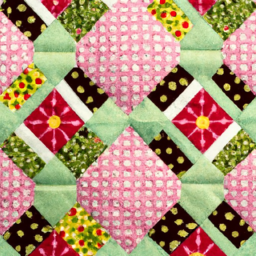

Quilting is an art form that has been passed down through generations, preserving memories and showcasing creativity in a unique way. One captivating technique within quilting is whole cloth quilting, where a single piece of fabric is used as the canvas for intricate stitching patterns. These patterns not only add a decorative touch but also provide opportunities for quilting enthusiasts to showcase their skills and create stunning masterpieces.
Understanding Whole Cloth Quilting
In whole cloth quilting, a quilt top is made from a single piece of fabric without any piecing involved. This means that the design and execution of the quilt are solely reliant on the fabric choice and the stitching patterns. It requires skillful quilting and attention to detail to bring forth the beauty of the fabric and create an eye-catching quilt.
Selection of Fabric
Choosing the right fabric is crucial in whole cloth quilting as it sets the foundation for the entire design. Most commonly, solid colors or fabrics with subtle patterns are preferred to showcase the quilting stitches. However, some quilters experiment with bold or vibrant prints to create a striking contrast.
The quality of the fabric also plays an important role in achieving a successful whole cloth quilt. Fabrics such as cotton, silk, and linen are popular choices due to their durability and ease of stitching. The fabric should be pre-washed and ironed before beginning the quilting process to ensure a smooth and even surface.
Popular Quilting Patterns
There are numerous quilting patterns that can be used in whole cloth quilts. Some popular choices include:
- Feathers: These elegant flowing designs are versatile and can be adapted to fit various quilt sizes and shapes.
- Grids and Diagonals: Creating a series of straight lines or diagonal patterns can add a modern and clean look to the quilt.
- Floral Motifs: Blossoms, vines, and leaves are often seen in whole cloth quilts, providing a delicate and nature-inspired touch.
- Geometric Patterns: Quilters can experiment with intricate geometric designs to add a contemporary feel to their quilts.

“Whole cloth quilting patterns offer a canvas for quilters to express their creativity and showcase their stitching skills. It’s a wonderful way to transform a single piece of fabric into a work of art.”
Tips for Successful Whole Cloth Quilting
To achieve an exceptional whole cloth quilt, consider the following tips:
- Practice makes perfect: Before working on your final quilt, practice your chosen patterns on a smaller fabric piece to familiarize yourself with the stitching techniques.
- Mark your fabric: Use temporary fabric markers or painter’s tape to mark the stitching lines and keep the patterns consistent.
- Pick the right thread: Choose high-quality thread in colors that complement your fabric. Contrasting or coordinating threads can enhance the quilt’s design.
- Experiment with different stitches: Varying the stitch length and style can create texture and depth in your quilt.
Whole cloth quilting patterns offer a canvas for quilters to express their creativity and showcase their stitching skills. It’s a wonderful way to transform a single piece of fabric into a work of art. Whether you prefer traditional motifs or contemporary designs, whole cloth quilting provides endless possibilities for quilters to explore and create remarkable quilts that will be cherished for generations to come.